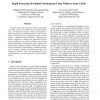Free Online Productivity Tools
i2Speak
i2Symbol
i2OCR
iTex2Img
iWeb2Print
iWeb2Shot
i2Type
iPdf2Split
iPdf2Merge
i2Bopomofo
i2Arabic
i2Style
i2Image
i2PDF
iLatex2Rtf
Sci2ools
CLOUDCOM
2010
Springer
2010
Springer
Rapid Processing of Synthetic Seismograms Using Windows Azure Cloud
Currently, numerically simulated synthetic seismograms are widely used by seismologists for seismological inferences. The generation of these synthetic seismograms requires large amount of computing resources, and the maintenance of these observed seismograms requires massive storage. Traditional high-performance computing platforms is inefficient to handle these applications because rapid computations are needed and large-scale datasets should be maintained. The emerging cloud computing platform provides an efficient substitute. In this paper, we introduce our experience on implementing a computational platform for rapidly computing and delivering synthetic seismograms on Windows Azure. Our experiment shows that cloud computing is an ideal platform for such kind of applications.
CLOUDCOM 2010 | Distributed And Parallel Computing | Observed Seismograms | Seismological Inferences | Synthetic Seismograms |
| Added | 10 Feb 2011 |
| Updated | 10 Feb 2011 |
| Type | Journal |
| Year | 2010 |
| Where | CLOUDCOM |
| Authors | Vedaprakash Subramanian, Liqiang Wang, En-Jui Lee, Po Chen |
Comments (0)

